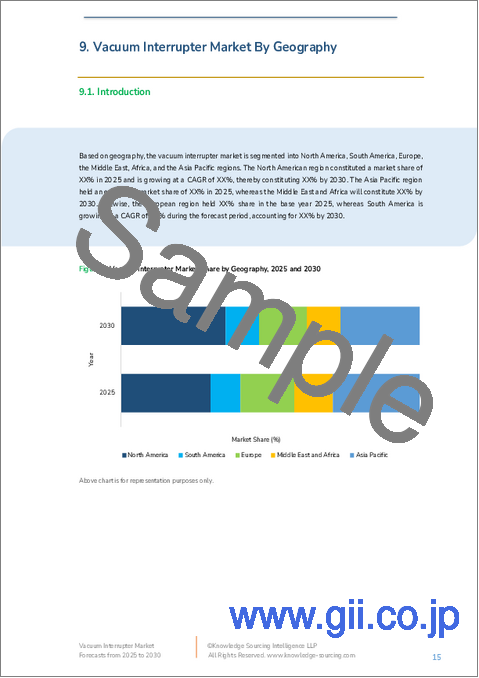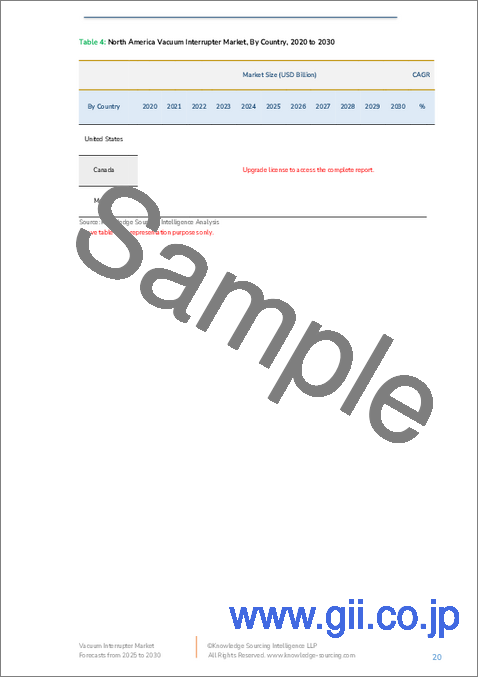|
|
市場調査レポート
商品コード
1775326
真空遮断器市場:将来予測 (2025年~2030年)Vacuum Interrupter Market - Forecasts from 2025 to 2030 |
||||||
カスタマイズ可能
|
|||||||
| 真空遮断器市場:将来予測 (2025年~2030年) |
|
出版日: 2025年06月23日
発行: Knowledge Sourcing Intelligence
ページ情報: 英文 140 Pages
納期: 即日から翌営業日
|
全表示
- 概要
- 目次
真空遮断器市場は、CAGR 6.07%で、2025年の25億400万米ドルから2030年には33億6,300万米ドルに成長すると予測されています。
真空遮断器は、真空サーキットブレーカの重要なコンポーネントであり、鉄道や産業プラントなどの産業にわたる公益送電、発電、配電システムで故障電流を遮断するために使用されます。真空遮断器の需要は、過負荷による損失を防ぐための堅牢な電気回路保護の必要性、鉄道用サーキットブレーカーにおける用途の拡大、環境に優しい特性などが背景にあります。
市場動向
市場は、負荷電流を管理し、過負荷や故障を自動的に処理する負荷遮断スイッチやリクローザなどの高度な回路保護装置において、真空遮断器への依存度が高まっていることによって推進されています。特にアジアを中心とする世界の鉄道インフラ拡張に後押しされ、鉄道用サーキットブレーカーでの使用が増加していることも大きな動向です。需要を牽引する主なプロジェクトは以下の通りです:
- High Speed 2 Phase I(英国):ロンドン-バーミンガム/リッチフィールド間、2019年着工、2026年完成予定
- Moscow-Kazan High-Speed Line(ロシア):2024年完成予定、インドネシア初の大量高速輸送システムの一部。
- ブリスベン・クロスリバー・レール(オーストラリア):ダットン・パークからボーエン・ヒルズまでを結ぶ鉄道で、2019年に着工、2024年の完成を目指します。
- 東莞3号線(中国):東莞市で建設中の66.2kmの鉄道。
これらのプロジェクトにより、信頼性の高いサーキットブレーカーのニーズが高まり、真空遮断器の需要を押し上げます。
促進要因
1.産業の拡大:公益事業、石油・ガス、建設、運輸セクターの成長が、真空遮断器に依存する真空サーキットブレーカの需要を牽引しています。送配電網の整備と並んで、これらの産業におけるプロジェクト活動の活発化が市場の成長を支えています。真空遮断器はエネルギーの浪費を減らし、送電コストを下げ、安全性を高めるため、好んで選ばれています。
2.電力需要の増加:急速な工業化と都市化別電力消費量が増加し、短絡を防止するために真空遮断器のような保護装置が必要とされています。真空遮断器の用途は中電圧システムで顕著であり、高圧シナリオでの使用も増加しています。
3.マクロ経済要因:人口増加、都市化、所得の増加は、電力、石油、インフラに対する需要を増大させます。先進諸国への移住は信頼性の高い電力システムの必要性をさらに高め、間接的に真空遮断器の売上を押し上げます。
4.環境面での利点:真空遮断器は、環境にやさしく、リサイクル可能で、ガス絶縁が不要であるため、世界の環境問題に合致しています。メーカーがエネルギー効率に優れた低炭素の機器を優先しているため、ガスベースの遮断器からの移行はその魅力を高めています。
課題
- コスト高と故障:真空遮断器は代替品よりもコストが高く、故障しやすいため、採用が進まない可能性があります。
- 認知度と政策格差:真空遮断器の認知度が低く、政府の政策も不十分であるため、市場成長の妨げになる可能性があります。
地理的展望
アジア太平洋は、インドや中国のような国々における所得増加、電力消費、製造活動によって大きく成長します。南北アメリカも、政府主導の大規模な建設・輸送プロジェクトにより、かなりのシェアを占めると思われます。
当レポートの主なメリット
- 洞察に満ちた分析:顧客セグメント、政府政策と社会経済要因、消費者の嗜好、産業別、その他のサブセグメントに焦点を当て、主要地域だけでなく新興地域もカバーする詳細な市場考察を得ることができます。
- 競合情勢:世界の主要企業が採用している戦略的作戦を理解し、適切な戦略による市場浸透の可能性を理解することができます。
- 市場促進要因と将来動向:ダイナミックな要因と極めて重要な市場動向、そしてそれらが今後の市場展開をどのように形成していくかを探ります。
- 行動可能な提言:ダイナミックな環境の中で、新たなビジネスストリームと収益を発掘するための戦略的意思決定に洞察を活用します。
- 幅広い利用者に対応:新興企業、研究機関、コンサルタント、中小企業、大企業にとって有益で費用対効果が高いです。
どのような用途で利用されていますか?
業界・市場考察、事業機会評価、製品需要予測、市場参入戦略、地理的拡大、設備投資決定、規制の枠組みと影響、新製品開発、競合の影響
分析範囲
- 過去のデータ(2022~2024年)と予測データ (2025~2030年)
- 成長機会、課題、サプライチェーンの展望、規制枠組み、顧客行動、動向分析
- 競合企業のポジショニング・戦略・市場シェア分析
- 収益成長率と予測分析:セグメント別・地域別 (国別)
- 企業プロファイリング (戦略、製品、財務情報、主な動向など)
目次
第1章 エグゼクティブサマリー
第2章 市場スナップショット
- 市場概要
- 市場の定義
- 調査範囲
- 市場区分
第3章 ビジネス情勢
- 市場促進要因
- 市場抑制要因
- 市場機会
- ポーターのファイブフォース分析
- 業界バリューチェーン分析
- ポリシーと規制
- 戦略的提言
第4章 技術展望
第5章 真空遮断器市場:電圧別
- イントロダクション
- 15kV未満
- 15~30kV
- 30kV以上
第6章 真空遮断器市場:流通チャネル別
- イントロダクション
- オンライン
- オフライン
第7章 真空遮断器市場:用途別
- イントロダクション
- サーキットブレーカー
- 負荷ブレーカー
- 再閉路装置
- タップチェンジャー
- その他
第8章 真空遮断器市場:エンドユーザー別
- イントロダクション
- 石油・ガス
- 鉱業
- 電力・ユーティリティ
- 交通機関
- その他
第9章 真空遮断器市場:地域別
- イントロダクション
- 北米
- 米国
- カナダ
- メキシコ
- 南米
- ブラジル
- アルゼンチン
- その他
- 欧州
- ドイツ
- フランス
- 英国
- スペイン
- その他
- 中東・アフリカ
- サウジアラビア
- アラブ首長国連邦
- その他
- アジア太平洋
- 中国
- インド
- 日本
- 韓国
- インドネシア
- タイ
- その他
第10章 競合環境と分析
- 主要企業と戦略分析
- 市場シェア分析
- 企業合併・買収 (M&A)、合意、事業協力
- 競合ダッシュボード
第11章 企業プロファイル
- ABB
- Siemens AG
- Chengdu Xuguang Electronics Co., Ltd
- Toshiba Corporation
- Eaton Corporation
- Meidensha Corporation
- CG Power and Industrial Solutions Ltd
- Mitsubishi Electric Corporation
- Schneider Electric SE
- GreenStoneUSA
第12章 付録
- 通貨
- 前提条件
- 基準年と予測年のタイムライン
- 利害関係者にとっての主なメリット
- 調査手法
- 略語
The vacuum interrupter market is expected to grow from USD 2.504 billion in 2025 to USD 3.363 billion in 2030, at a CAGR of 6.07%.
Vacuum interrupters are critical components in vacuum circuit breakers, used to interrupt fault currents in utility power transmission, power generation, and distribution systems across industries like railways and industrial plants. Their demand is driven by the need for robust electrical circuit protection to prevent losses from overloads, growing applications in railway circuit breakers, and eco-friendly attributes.
Market Trends
The market is propelled by the increasing reliance on vacuum interrupters in advanced circuit protection devices, such as load break switches and reclosers, which manage load currents and automatically handle overloads or faults. A significant trend is their growing use in railway circuit breakers, fueled by global railway infrastructure expansion, particularly in Asia. Key projects driving demand include:
- High Speed 2 Phase I (UK): London-Birmingham/Lichfield, started in 2019, expected completion by 2026.
- Moscow-Kazan High-Speed Line (Russia): Set for completion in 2024, part of Indonesia's first mass rapid transit system.
- Brisbane Cross River Rail (Australia): Spanning Dutton Park to Bowen Hills, started in 2019, targeted for 2024 completion.
- Dongguan Line 3 (China): A 66.2 km railway under construction in Dongguan.
These projects increase the need for reliable circuit breakers, boosting vacuum interrupter demand.
Growth Drivers
1. Industrial Expansion: Growth in utilities, oil & gas, construction, and transportation sectors drives demand for vacuum circuit breakers, which rely on vacuum interrupters. Rising project activity in these industries, alongside transmission and distribution network development, supports market growth. Vacuum interrupters reduce energy wastage, lower transmission costs, and enhance safety, making them a preferred choice.
2. Rising Electricity Demand: Rapid industrialization and urbanization have increased electricity consumption, necessitating protective devices like vacuum interrupters to prevent short circuits. Their applications are prominent in medium-voltage systems, with growing use in high-voltage scenarios.
3. Macroeconomic Factors: Population growth, urbanization, and rising incomes increase demand for electricity, oil, and infrastructure. Migration to developed countries further amplifies the need for reliable power systems, indirectly boosting vacuum interrupter sales.
4. Environmental Benefits: Vacuum interrupters are eco-friendly, recyclable, and free of gas insulation, aligning with global environmental concerns. This shift from gas-based interrupters enhances their appeal, as manufacturers prioritize energy-efficient, low-carbon equipment.
Challenges
- High Costs and Malfunctions: Vacuum interrupters are costlier than alternatives and prone to malfunctions, which may deter adoption. However, ongoing technological advancements are expected to mitigate these issues.
- Awareness and Policy Gaps: Limited awareness of vacuum interrupters and inadequate government policies could hinder market growth.
Geographical Outlook
The Asia Pacific region is poised for significant growth, driven by rising incomes, electricity consumption, and manufacturing activity in countries like India and China. The Americas will also hold a substantial share due to extensive government-led construction and transportation projects.
Key Benefits of this Report:
- Insightful Analysis: Gain detailed market insights covering major as well as emerging geographical regions, focusing on customer segments, government policies and socio-economic factors, consumer preferences, industry verticals, and other sub-segments.
- Competitive Landscape: Understand the strategic maneuvers employed by key players globally to understand possible market penetration with the correct strategy.
- Market Drivers & Future Trends: Explore the dynamic factors and pivotal market trends and how they will shape future market developments.
- Actionable Recommendations: Utilize the insights to exercise strategic decisions to uncover new business streams and revenues in a dynamic environment.
- Caters to a Wide Audience: Beneficial and cost-effective for startups, research institutions, consultants, SMEs, and large enterprises.
What do businesses use our reports for?
Industry and Market Insights, Opportunity Assessment, Product Demand Forecasting, Market Entry Strategy, Geographical Expansion, Capital Investment Decisions, Regulatory Framework & Implications, New Product Development, Competitive Intelligence
Report Coverage:
- Historical data from 2022 to 2024 & forecast data from 2025 to 2030
- Growth Opportunities, Challenges, Supply Chain Outlook, Regulatory Framework, and Trend Analysis
- Competitive Positioning, Strategies, and Market Share Analysis
- Revenue Growth and Forecast Assessment of segments and regions including countries
- Company Profiling (Strategies, Products, Financial Information, and Key Developments among others.
Segmentation:
By Voltage
- Up to 15 kV
- 15 to 30 kV
- Greater than 30 kV
By Distribution Channel
- Online
- Offline
By Application
- Circuit Breaker
- Load Breaker
- Reclosers
- Tap-Changer
- Others
By End-User
- Oil & Gas
- Mining
- Power & Utilities
- Transportation
- Others
By Geography
- North America
- USA
- Canada
- Mexico
- South America
- Brazil
- Argentina
- Others
- Europe
- UK
- Germany
- France
- Italy
- Spain
- Others
- Middle East and Africa
- Saudi Arabia
- UAE
- Israel
- Others
- Asia Pacific
- Japan
- China
- India
- South Korea
- Taiwan
- Thailand
- Indonesia
- Others
TABLE OF CONTENTS
1. EXECUTIVE SUMMARY
2. MARKET SNAPSHOT
- 2.1. Market Overview
- 2.2. Market Definition
- 2.3. Scope of the Study
- 2.4. Market Segmentation
3. BUSINESS LANDSCAPE
- 3.1. Market Drivers
- 3.2. Market Restraints
- 3.3. Market Opportunities
- 3.4. Porter's Five Forces Analysis
- 3.5. Industry Value Chain Analysis
- 3.6. Policies and Regulations
- 3.7. Strategic Recommendations
4. TECHNOLOGICAL OUTLOOK
5. VACUUM INTERRUPTER MARKET BY VOLTAGE
- 5.1. Introduction
- 5.2. Up to 15 kV
- 5.3. 15 to 30 kV
- 5.4. Greater than 30 kV
6. VACUUM INTERRUPTER MARKET BY DISTRIBUTION CHANNEL
- 6.1. Introduction
- 6.2. Online
- 6.3. Offline
7. VACUUM INTERRUPTER MARKET BY APPLICATION
- 7.1. Introduction
- 7.2. Circuit Breaker
- 7.3. Load Breaker
- 7.4. Reclosers
- 7.5. Tap-Changer
- 7.6. Others
8. VACUUM INTERRUPTER MARKET BY END-USER
- 8.1. Introduction
- 8.2. Oil & Gas
- 8.3. Mining
- 8.4. Power & Utilities
- 8.5. Transportation
- 8.6. Others
9. VACUUM INTERRUPTER MARKET BY GEOGRAPHY
- 9.1. Introduction
- 9.2. North America
- 9.2.1. USA
- 9.2.2. Canada
- 9.2.3. Mexico
- 9.3. South America
- 9.3.1. Brazil
- 9.3.2. Argentina
- 9.3.3. Others
- 9.4. Europe
- 9.4.1. Germany
- 9.4.2. France
- 9.4.3. United Kingdom
- 9.4.4. Spain
- 9.4.5. Others
- 9.5. Middle East and Africa
- 9.5.1. Saudi Arabia
- 9.5.2. UAE
- 9.5.3. Others
- 9.6. Asia Pacific
- 9.6.1. China
- 9.6.2. India
- 9.6.3. Japan
- 9.6.4. South Korea
- 9.6.5. Indonesia
- 9.6.6. Thailand
- 9.6.7. Others
10. COMPETITIVE ENVIRONMENT AND ANALYSIS
- 10.1. Major Players and Strategy Analysis
- 10.2. Market Share Analysis
- 10.3. Mergers, Acquisitions, Agreements, and Collaborations
- 10.4. Competitive Dashboard
11. COMPANY PROFILES
- 11.1. ABB
- 11.2. Siemens AG
- 11.3. Chengdu Xuguang Electronics Co., Ltd
- 11.4. Toshiba Corporation
- 11.5. Eaton Corporation
- 11.6. Meidensha Corporation
- 11.7. CG Power and Industrial Solutions Ltd
- 11.8. Mitsubishi Electric Corporation
- 11.9. Schneider Electric SE
- 11.10. GreenStoneUSA
12. APPENDIX
- 12.1. Currency
- 12.2. Assumptions
- 12.3. Base and Forecast Years Timeline
- 12.4. Key benefits for the stakeholders
- 12.5. Research Methodology
- 12.6. Abbreviations





